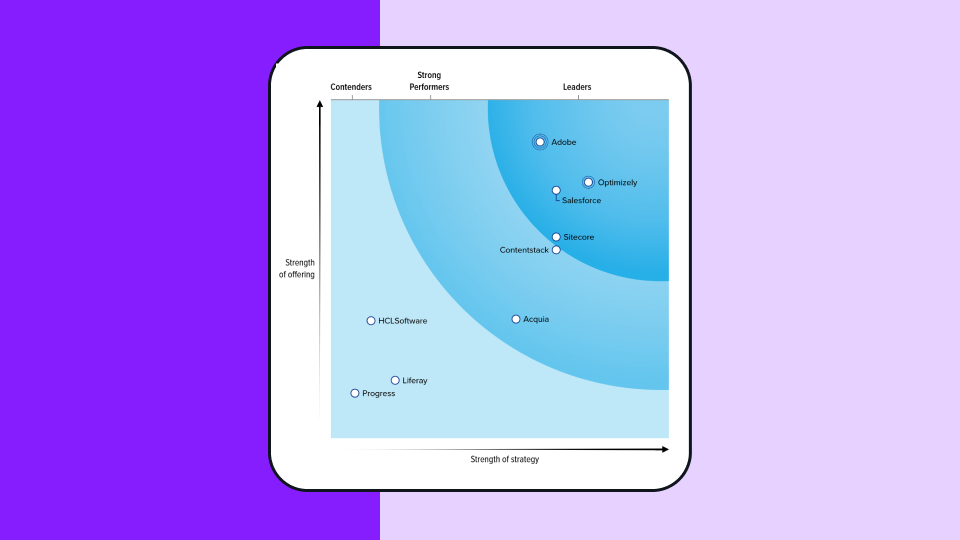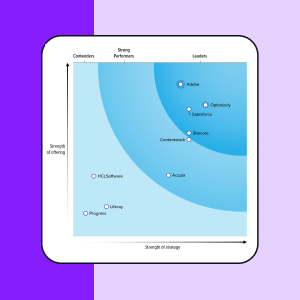Erlebnismarketing
Was ist Erlebnismarketing?
Erlebnismarketing (manchmal auch als Engagement- oder Eventmarketing bezeichnet) ist eine Marketingstrategie, die darauf abzielt, dem Publikum einzigartige, markenbezogene Erlebnisse zu bieten. Ziel ist es, die Markenwahrnehmung und das Kaufverhalten der Kunden durch ihre aktive Teilnahme am Markenerlebnis zu beeinflussen.
Erlebnismarketing-Kampagnen können viele Formen annehmen. Beispiele sind Pop-ups, Touren, Markenaktivierungen, Kurse, Workshops, Seminare, einmalige Veranstaltungen oder Partys. Erlebnismarketing trägt zur Diversifizierung der Marketingbemühungen bei und ermöglicht es Marken und Unternehmen, über den traditionellen Monolog der visuellen Werbung hinauszugehen. Auf diese Weise bieten kundenorientierte Erlebnisse Marken die Möglichkeit, ihre Produkte, ihre Stimme und ihre Identität zu differenzieren.
Es ist auch üblich, dass Marken Erlebnismarketing als multisensorisches Marketing bezeichnen, da sie sensorische Komponenten nutzen können, um ihre Bemühungen um Erlebnisse zu verstärken. Erlebnismarketing kann sowohl online als auch offline stattfinden, wobei viele Marken innovative Software einsetzen, um den Erfolg ihrer Bemühungen zu messen. Die kreative Natur des Erlebnismarketings ermöglicht es den Vermarktern, eine Vielzahl von Teilstrategien einzusetzen, um die Verbraucher durch unvergessliche Erlebnisse in Echtzeit zu begeistern und zu beeinflussen.
Erlebnismarketing vs. Eventmarketing
Live-Events sind die häufigste Form des Erlebnismarketings. Obwohl der Begriff Eventmarketing traditionell häufiger verwendet wird, beginnt er, mit dem Erlebnismarketing zusammenzuführen.
Events sind in der Lage, Verbraucher zu unterhalten, soziale Medien zu integrieren und einer Marke, einer Dienstleistung oder einem Produkt einen Kontext hinzuzufügen, den der Verbraucher in Echtzeit erleben und lernen kann. Daher sind Events in der Lage, eine Vielzahl von Teilstrategien des Erlebnismarketings dynamisch einzubinden, wie z.B. Sensory Marketing, Immersive Marketing und Engagement Marketing.
In der heutigen Post-Covid-Umgebung müssen Erlebnismarketing-Events nicht mehr zwangsläufig persönlich stattfinden - virtuelle Events erfreuen sich bei Marketingfachleuten wachsender Beliebtheit. Es gibt eine Fülle von Online-Event-Plattformen, die es Marketern ermöglichen, einzigartige digitale Erlebnisse für das Marketing zu schaffen, die Nutzer über das Internet ansprechen.
Ein weiterer wachsender Trend sind hybride Veranstaltungen, die Elemente von realen Veranstaltungen mit virtuellen Erlebnissen kombinieren. Hybride Veranstaltungen können das Beste aus beiden Welten sein, indem sie das persönliche Networking und die Gespräche mit Online-Elementen wie Live-Streaming, Engagement in den sozialen Medien über Hashtags und mehr verbinden. Die Weitergabe von Sessions einer Live-Veranstaltung zu einem späteren Zeitpunkt in einem virtuellen Format kann eine großartige Content Marketing-Strategie sein, die es Vermarktern ermöglicht, bereits erstellte hochwertige Inhalte wiederzuverwenden.
Warum sollten Sie in Erlebnismarketing investieren?
Erlebnismarketing funktioniert. Erlebnismarketing hilft Marken nicht nur, sich in einem überfüllten Markt zu differenzieren, sondern ist auch eine Marketingtaktik, die genau dem entspricht, was die Verbraucher heute wünschen: Erlebnisse. Daten haben gezeigt, dass Verbraucher 4x eher bereit sind, in Erlebnisse zu investieren, und dass der Wert eines "Erlebniskaufs" mit der Zeit zunimmt.
Verbraucher aller Bevölkerungsgruppen, von den GenZern bis zu den Babyboomern, stimmen darin überein, dass Erlebnisse die Möglichkeit bieten, bedeutungsvolle soziale Beziehungen aufzubauen und dass Erlebnisse zu einem bedeutungsvollen Teil der eigenen Identität werden. Daher bietet Erlebnismarketing den Marken die Möglichkeit, mit den Verbrauchern auf einer persönlichen Ebene in einem Format zu interagieren, das sie aktiv suchen.
Unvergessliche Erlebnisse sind von Natur aus persönlich und in der Lage, eine Marke zu vermenschlichen. Sie bieten ein persönliches Customer Engagement und geben den Verbrauchern das Gefühl, dass sie bei einer vertrauten Persönlichkeit und nicht nur bei einem Unternehmen kaufen. Aus diesem Grund haben mehr als die Hälfte aller Vermarkter begonnen, in immersive Erlebnisse zu investieren, da diese mehr Leads, Verkäufe und langfristige Loyalität generieren als traditionelle Marketingmaßnahmen.
Mit der Zeit kann Erlebnismarketing ein wirkungsvolles Instrument sein, um die Markentreue zu erhöhen, indem es emotionale Bindungen zu begeisterten Kunden aufbaut, die dann zu Markenbotschaftern und Influencern werden, die dabei helfen, die Botschaften der Marke in ihren Netzwerken zu verbreiten.
Die Vorteile des Erlebnismarketings
Erlebnismarketing bietet die Möglichkeit, durch einen interaktiven Dialog direkt mit den Verbrauchern zu kommunizieren. Erlebnisse werden von den Verbrauchern nicht als traditionelles Marketing wahrgenommen. Daher können Marken das Erlebnismarketing nutzen, um ihre Werte wirksam zu vermitteln und zu zeigen, dass der Kunde im Mittelpunkt ihrer Aufmerksamkeit, ihres Interesses und ihrer Mission steht. Es ermöglicht Marken, die Verbraucher in einer zunehmend schnelllebigen, digitalen Welt dort abzuholen, wo sie sind, und sich von den traditionellen Berührungspunkten zu entfernen, die die Verbraucher bereits erwarten und oft ignorieren. Erlebnismarketing bietet auch Echtzeiteinblicke in die Art und Weise, wie Verbraucher eine Marke wahrnehmen und mit ihr umgehen.
Momente des Engagements und der Interaktion können wertvolle First-Party-Daten durch Registrierungen, Anmeldungen oder die Nutzung sozialer Medien generieren.
Einige Erlebnisprogramme dienen dazu, ein neues Produkt oder eine neue Dienstleistung bekannt zu machen, z. B. durch das Angebot von Mustern bei einem Pop-up.
Andere zielen darauf ab, eine langfristige Loyalität zu fördern - zum Beispiel durch Fahrerlebnisse oder Online-Kurse, die den Wert, die Funktion und die Persönlichkeit eines Produkts oder einer Dienstleistung demonstrieren.
Erfolgsmethoden und Messung des Erlebnismarketings
Bei der Entwicklung einer Marketingstrategie für Erlebnismarketing ist es am besten, die verschiedenen Komponenten, die das Erlebnis als Ganzes ausmachen, zu planen und zu besprechen. Es ist wichtig, dass das Erlebnis dazu beiträgt, Ihre Marke zu vermenschlichen, und dass ein "Buzz" erzeugt wird.
Wie wird das Erlebnis die Sinne des Kunden ansprechen? Welche Art von Klängen, visuellen Eindrücken oder Düften werden einbezogen? Sensorisches Marketing zielt darauf ab, alle fünf Sinne einzubeziehen, um das Verbraucherverhalten unbewusst zu beeinflussen. Studien haben gezeigt, dass die Einbeziehung der Sinne der Verbraucher nicht nur die Wirksamkeit des Erlebnismarketings erhöht, sondern auch zu einer langfristigen Kundenbindung beiträgt.
Prüfen Sie, was über Ihr Publikum bekannt ist, um Requisiten, Spiele, gesellschaftlich relevante Inhalte und/oder Musik einzubinden, die die Interessen Ihrer Kunden am stärksten ansprechen und die Werte Ihrer Marke ergänzen.
Legen Sie im Vorfeld des Erlebnisses einen Messrahmen fest. Registrierungen und Teilnehmerzahlen lassen sich nur schwer mit dem Umsatz und der tatsächlichen Wirkung in Verbindung bringen. Viele Marken nutzen Metriken wie Net Promoter Scores (NPS) und Conversions als Frühindikatoren für den Erfolg und schauen weiter unten im Trichter auf die Kaufabsicht und die Auswirkungen auf den Umsatz.
Achten Sie auf ein bewusstes Design - es ist wichtig, dass das Erlebnis die Kunden "begeistert" und einen bleibenden Eindruck hinterlässt. Dies ist besonders wichtig in einer Post-Covid-Umgebung, in der sich die Interaktion mit Kunden weitgehend auf ein digitales Medium beschränkt. Ganz gleich, ob Sie ein hybrides oder ein reines Online-Erlebnis haben, denken Sie immer an das Erlebnis für den Kunden und schaffen Sie etwas, das in Erinnerung bleibt, sei es ein Live-Erlebnis oder ein virtuelles Browsing-Erlebnis.
Es ist wichtig, dass Sie Ihren Kunden zuhören. Sammeln Sie Feedback durch Umfragen, die nachverfolgt und zentralisiert werden, um daraus verwertbare Erkenntnisse zu gewinnen. Die Rückmeldungen geben Aufschluss darüber, wie Ihre Kunden das Erlebnis wahrgenommen haben und mit welchen Gefühlen sie nach Hause gegangen sind. Auf diese Weise können Sie den Erfolg des Erlebnisses bewerten und auch künftige Maßnahmen verbessern.
Beispiele für Erlebnismarketing
Im Folgenden finden Sie Beispiele für Erlebnismarketing-Erlebnisse, die großen Marken geholfen haben, ihre Markenbekanntheit und Markentreue zu steigern:
- Der Track Day von BMW ist eine Veranstaltung, die sensorisches Marketing einsetzt, um das Erlebnis der Teilnehmer zu verbessern. Die Veranstaltung findet in einer sportlichen Garage statt und setzt die Teilnehmer dem Geruch von Reifen und Öl aus. Die Teilnehmer hören das Kurbeln von Schraubenschlüsseln und das Hochdrehen von BMW Motoren. Mehrere Autos und Modelle ermöglichen es den Teilnehmern, die hochwertige Innenausstattung und die sportlichen Konturen von BMW durch Berührung zu erleben. All diese sinnlichen Erlebnisse tragen dazu bei, den Eindruck zu prägen, den potenzielle Kunden von BMW und seinen Autos mitnehmen.
- Adidas lancierte den 'D Rose Jump Store' als interaktives Pop-up, bei dem die Teilnehmer versuchen konnten, ein Paar Schuhe der Marke Derek Rose aus einem 10 Fuß hohen Regal zu ergattern. Die Veranstaltung trug dazu bei, Derek Rose und seine Adidas-Markenschuhe einer neuen Zielgruppe in Großbritannien vorzustellen. Durch die physische Teilnahme an dem Pop-up-Event hatten die Verbraucher ein unvergessliches, interaktives Erlebnis, das ihnen einen neuen Eindruck von Basketball, Derek Rose und Adidas-Schuhen vermittelte.
- Coca-Cola ist dafür bekannt, viele innovative Erlebnismarketing-Kampagnen durchzuführen. Ein bemerkenswertes Beispiel ist eine Valentinstagskampagne von Coca-Cola, bei der ein 'unsichtbarer Automat' an einer Wand in New York City erschien, als ein Paar zufällig vorbeikam. Der Automat fragte dann nach den Namen des Paares und erstellte ein personalisiertes Andenken, das viele Paare mit ihm teilten. Dies führte zu einem viralen Marketingerlebnis und einer erhöhten Mund-zu-Mund-Propaganda.

